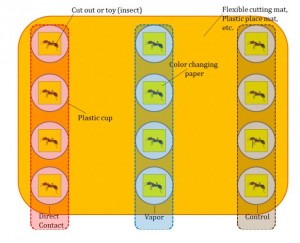
This experiment will test if the insects will die (i.e., the yellow color changing paper turning red once it comes in contact with a weak basic solution) once they have come in contact with crude oil through various exposure routes.
Many times, people think about the environmental impacts of an oil spill and the main organisms (impacted) that come to mind are marine mammals, crustaceans, fish, birds, and even mollusks. Insects are often forgotten, but some species are closely associated to soil and plant life; therefore, some insects are of high ecological value. Some insects live within the shoots of dead Spartina, directly exposed to marshes in which oil contamination has occurred. Researchers want to know what happens to some of these insects that are exposed to oil by various means (e.g., direct contact, inhalation, ingestion, etc.).
The most recent and notable offshore drilling incident was the BP Deepwater Horizon oil spill which was responsible for releasing millions of barrels of oil into the Gulf of Mexico and the surrounding coast.
Students will be re-enacting a methodology initiated by GoMRI researchers to identify insect abundance on oiled and unoiled plots of land. The weak basic solution (i.e., baking soda and water) will represent crude oil. Students will expose 2 out of 3 columns of insects to ‘oiled water’ that may be found in salt marshes along the Gulf coast.
